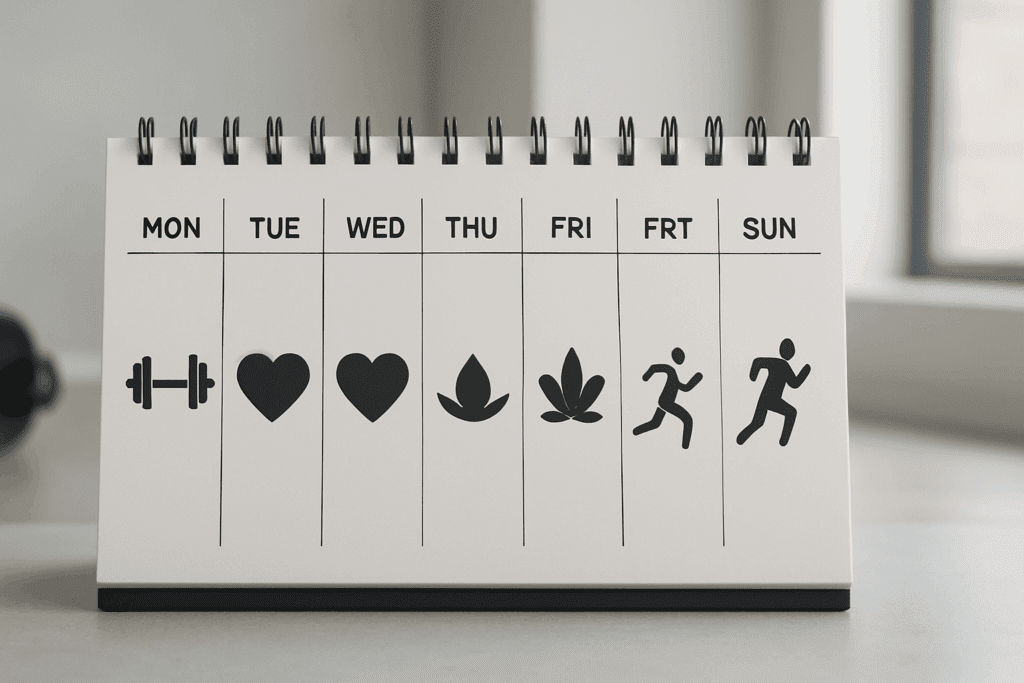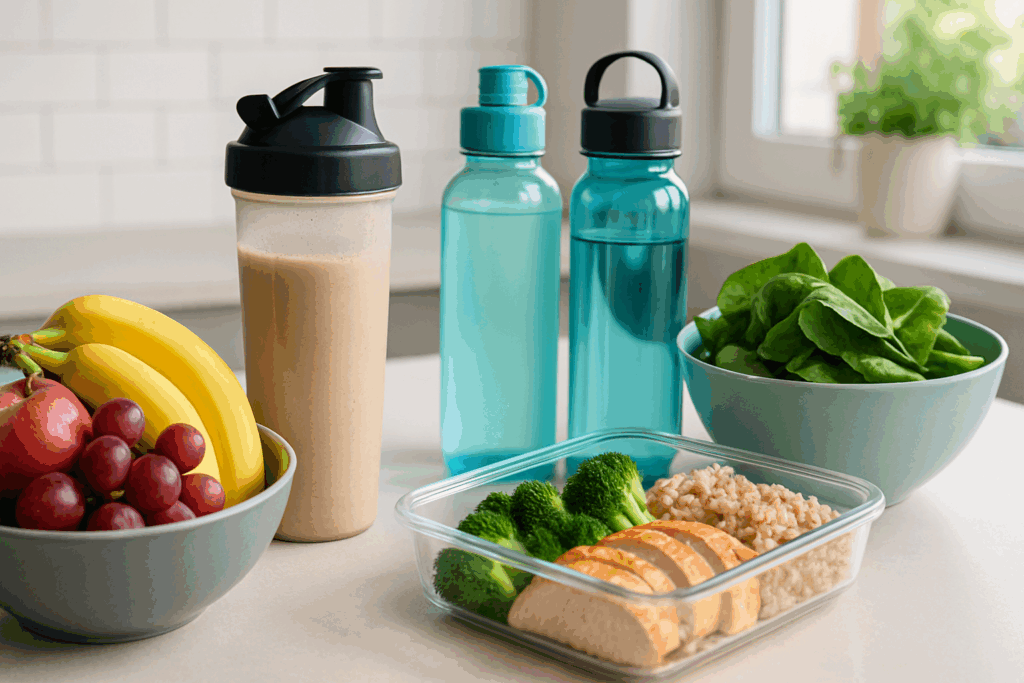Unlocking the Power of Daily Training for Sustainable Fitness
For many fitness enthusiasts and athletes alike, the concept of exercising every day of the week seems both exhilarating and intimidating. The idea of a 7 day fitness plan, however, isn’t just for elite competitors or bodybuilders. With the right structure, strategy, and understanding of one’s own body, anyone can benefit from a consistent, well-balanced approach to physical activity. Training seven days a week does not have to mean pushing the body to exhaustion or risking overtraining. Rather, a properly designed plan ensures that each day is purpose-driven, helping individuals optimize endurance, build strength, enhance recovery, and foster sustainable habits.
You may also like: How to Increase Stamina and Endurance Naturally: Smart Training Tips and Nutrition Habits That Support Cardiovascular Fitness
When considering a plan to workout seven days a week, it’s crucial to recognize that the key to success lies in intelligent programming. Instead of focusing purely on intensity, a smart 7 day workout split rotates intensity levels, muscle groups, and training modalities to ensure comprehensive conditioning and recovery. For those who view each day as a gym day, the shift in mindset must prioritize quality over quantity and recovery as a performance enhancer. A well-structured plan that allows for variation, recovery, and adaptation can dramatically enhance performance, stamina, and mental fortitude over time.

The Science Behind Exercising Seven Days a Week
From a physiological standpoint, daily exercise can provide numerous benefits—provided that the plan is diversified and aligned with individual fitness levels. Regular movement stimulates cardiovascular health, improves muscular endurance, supports mental clarity, and fosters emotional well-being. What differentiates an effective 7 day fitness plan from overexertion is its balance. It avoids monotony, distributes load, and strategically implements rest through active recovery days rather than full inactivity.
The human body thrives on consistency and adapts to stress through recovery and repetition. Muscular adaptation, enhanced oxygen uptake, and improved neuromuscular coordination are all cumulative effects that stem from frequent, structured exercise. When programmed correctly, gym days that span an entire week can actually reduce injury risk by preventing the stop-start nature of sporadic routines that often lead to strain or imbalance. By incorporating various training methods—such as low-intensity cardio, functional movement, resistance training, and mobility work—into the 7 day workout split, individuals can train intelligently while respecting their body’s need for variation.
Moreover, the mental benefits of consistent movement cannot be overstated. Daily physical activity supports neurochemical balance, reduces symptoms of anxiety and depression, and fosters cognitive resilience. For many, movement becomes not only a means to physical fitness but also a cornerstone of mental wellness. With a strategically designed approach, those who choose to exercise 7 days a week often report greater mood stability, improved sleep quality, and enhanced focus throughout the day.

Designing a Balanced 7 Day Workout Split
The foundation of any sustainable daily workout routine lies in its variety. A well-rounded 7 day workout split should include strength, endurance, mobility, and recovery components. Each gym day should be unique in focus, targeting different physiological systems and muscle groups. This not only minimizes the risk of burnout but also allows for progressive adaptation and improvement across multiple domains of fitness.
For example, a balanced weekly routine might include lower body strength training on Monday, upper body hypertrophy on Tuesday, cardiovascular conditioning on Wednesday, functional training and core work on Thursday, full-body power development on Friday, active recovery with yoga or low-impact movement on Saturday, and long-duration endurance work on Sunday. This rotation ensures that each muscle group is trained effectively while avoiding consecutive days of high-intensity loading.
Flexibility is also essential. Days exercise routines should accommodate life’s unpredictability while maintaining consistency. The objective isn’t perfection, but rather, long-term commitment. By implementing autoregulation—listening to how your body feels and adjusting intensity accordingly—you build a habit that is not only effective but also sustainable. When designed with intention, a seven-day plan becomes a rhythm that enhances rather than depletes.

Endurance Training: Building Stamina Without Overtraining
For those aiming to improve cardiovascular performance and muscular stamina, endurance training must be approached with care when incorporated into a daily regimen. The key is alternating between high and low-intensity cardio to manage cumulative fatigue. While sprint intervals and tempo runs are essential for improving VO2 max and anaerobic capacity, longer steady-state efforts promote fat oxidation, cardiovascular resilience, and active recovery.
Integrating endurance work into a 7 day fitness plan means weaving it through other forms of training rather than isolating it. For instance, adding a moderate-intensity bike ride post-strength training or using swimming as an active recovery modality supports stamina development without overtaxing the body. Such integration promotes a holistic model of fitness that allows performance enhancement without compromising recovery.
Importantly, proper fueling and hydration play a pivotal role in supporting high-frequency endurance work. Carbohydrates and electrolytes are essential for sustaining energy levels, and protein ensures muscle repair. Monitoring heart rate variability and subjective energy levels can help fine-tune training volume. For individuals exercising 7 days a week, awareness of physiological signals becomes a critical element of performance longevity.
Performance Enhancement Through Intelligent Programming
Achieving performance enhancement is not about doing more, but doing better. Strategic programming ensures that each gym day is part of a larger, periodized plan designed to produce specific adaptations. Strength phases, hypertrophy blocks, deload weeks, and peak performance periods should be programmed cyclically to avoid stagnation and optimize results. This type of intelligent design is where science and art converge in athletic training.
Incorporating principles of progressive overload is crucial in a 7 day workout split. This doesn’t necessarily mean lifting heavier every day but may involve increasing training density, improving movement efficiency, or enhancing muscular time under tension. Each variable can be manipulated to foster progress without pushing toward overtraining. Additionally, incorporating rest-based training methods—where intensity is high but rest is integrated as needed within the workout—can allow for high-performance outputs without long-term systemic fatigue.
Supplementing physical training with neuromuscular education also aids performance. Movement quality, proprioception, and coordinated strength improve through dynamic warm-ups, mobility drills, and activation sequences. When approached holistically, a plan to workout seven days a week becomes a vehicle for high-level athletic development rather than a path to exhaustion.

Integrating Recovery and Mobility Into Daily Workouts
A common misconception about a 7 day fitness plan is that it lacks recovery. In truth, recovery is woven into the plan through intentional variation and active modalities. Recovery doesn’t always mean inactivity; it means promoting healing, reducing inflammation, and facilitating circulation. Techniques such as foam rolling, myofascial release, contrast therapy, and dynamic stretching are essential recovery practices that can be seamlessly integrated into daily routines.
Mobility work deserves its own place in a daily exercise plan. Poor mobility limits movement quality, increases injury risk, and impairs performance. By dedicating time each day to joint mobility—especially around the hips, shoulders, spine, and ankles—you ensure long-term functionality and strength. Many elite athletes include 15 to 30 minutes of mobility work daily to sustain high-level performance over time.
Including recovery-based gym days, such as guided yoga sessions, meditation-focused movement, or low-intensity swimming, offers the physical and psychological reset that fuels future training. In this way, recovery is not a break from the 7 day workout split but rather an integral and irreplaceable element of it.

The Mental Edge: Discipline, Motivation, and Cognitive Benefits
Daily training fosters a unique mental resilience. The act of showing up every day, regardless of mood or motivation, builds discipline that extends far beyond the gym. This discipline becomes the foundation for personal excellence, influencing productivity, decision-making, and emotional stability. While motivation may fluctuate, routine becomes the bridge between intention and action.
From a neurobiological perspective, daily movement supports the release of endorphins, serotonin, dopamine, and brain-derived neurotrophic factor (BDNF), all of which contribute to enhanced cognitive function, reduced stress, and greater emotional balance. This biochemical cascade supports long-term brain health and mental well-being, making daily exercise as much a tool for the mind as it is for the body.
Moreover, exercising daily creates structure. For those who thrive on routine, the predictability of daily movement can anchor the day and offer a sense of control. Even on rest-focused days, maintaining movement contributes to a psychological rhythm that promotes mental clarity. Those who follow a consistent 7 day fitness plan often report improved confidence, greater self-awareness, and a more optimistic outlook on life.
Nutritional Considerations for High-Frequency Training
Supporting a plan to exercise 7 days a week requires intentional nutrition. Caloric needs increase with frequent training, and macronutrient balance becomes essential for both performance and recovery. Carbohydrates serve as the body’s primary fuel, particularly for high-intensity or long-duration workouts, while fats support hormonal health and endurance. Protein is critical for muscle repair, immune function, and satiety.
Timing also matters. Pre-workout meals should support energy availability, while post-workout meals focus on replenishment and repair. Hydration is equally vital, and electrolyte balance must be monitored—especially during extended gym days or endurance training in hot environments. Without appropriate nutrition, even the best-designed workout plan can fall short of its potential.
In addition, micronutrient density should not be overlooked. Iron, magnesium, zinc, and B-vitamins all play vital roles in energy metabolism, oxygen transport, and muscular function. Individuals who train daily should regularly assess their dietary intake and consider supplementation if deficiencies are identified. A strong foundation of whole foods, nutrient-dense meals, and hydration supports the body’s ability to adapt to high training loads without compromising health.

Avoiding Burnout and Overtraining: Listening to Your Body
Even with a strategic 7 day fitness plan, the risk of burnout remains if physical cues are ignored. Overtraining is not defined solely by frequency but by the mismatch between stress and recovery. Warning signs such as persistent fatigue, irritability, sleep disturbances, diminished performance, and frequent illness must be taken seriously. Rest and recalibration are not signs of weakness but of wisdom.
Implementing deload weeks—periods where training intensity or volume is intentionally reduced—can help prevent burnout while maintaining consistency. Likewise, using metrics such as heart rate variability (HRV), sleep tracking, and subjective well-being assessments allows individuals to adapt their plan in real-time. This responsiveness transforms a rigid plan into a dynamic and sustainable lifestyle.
Ultimately, exercising seven days a week is not a badge of honor but a conscious choice to pursue health, vitality, and performance in a thoughtful way. Recovery, mindset, and personal awareness are as critical as the workouts themselves. With the right tools and perspective, burnout can be avoided, and results can be sustained for years.
Frequently Asked Questions: Maximizing Results with a 7 Day Fitness Plan
1. Is it truly sustainable to workout seven days a week without risking injury or burnout?
While it may sound extreme to exercise 7 days a week, sustainability hinges on how the program is structured. A smart approach includes varied intensities and active recovery built into the 7 day fitness plan, allowing the body to adapt rather than break down. For instance, alternating high-intensity strength work with low-impact activities like mobility flows, brisk walking, or swimming can prevent overuse injuries. The idea isn’t to push hard on all gym days, but rather to engage in intentional movement that serves a purpose. The long-term success of a plan that includes days exercise continuously lies in how well it balances effort with regeneration.
2. How do social and psychological factors influence the decision to train on all seven gym days?
Cultural expectations, personal identity, and social comparison can deeply influence fitness behavior. Many individuals commit to a 7 day workout split not purely for physical transformation but because of a sense of identity tied to consistency and self-discipline. Social media platforms often showcase individuals who workout seven days a week, which can create aspirational yet unrealistic standards. It’s crucial to align your 7 day fitness plan with your own needs rather than external pressures. Developing a healthy relationship with training means knowing when to rest and recognizing that mental recovery is just as important as physical restoration.
3. Can older adults or beginners follow a 7 day workout split safely?
Yes, but the plan must be tailored to meet individual capacity, experience, and mobility. For older adults or fitness novices, a 7 day fitness plan might prioritize joint health, balance training, and cardiovascular efficiency over high-impact strength work. A combination of functional movement, resistance bands, chair-based exercises, and water aerobics can allow for daily gym days without added joint stress. The frequency of days exercise doesn’t have to mean high exertion—it can be about building habits and preserving mobility. A well-coached plan can empower beginners to develop consistency while honoring their starting point.
4. What role does sleep play in supporting a plan to exercise 7 days a week?
Sleep is one of the most underrated variables in fitness progress, particularly when training daily. For those following a 7 day workout split, the body relies on deep sleep phases to complete muscular repair and regulate hormones like cortisol and testosterone. Without adequate sleep, the benefits of even the most perfectly designed gym days may be blunted. Sleep quality also influences cognitive function and decision-making, which affect motivation and exercise adherence. If you want to safely exercise 7 days a week, prioritize sleep hygiene as rigorously as your workout schedule.
5. Can high-performance athletes and everyday professionals both benefit from a 7 day fitness plan?
Absolutely—though the design and objectives will differ. Elite athletes often follow a 7 day workout split to fine-tune performance and prepare for competition, with meticulous attention to recovery protocols. On the other hand, busy professionals may embrace gym days as a way to manage stress, maintain cardiovascular health, and boost productivity. The flexibility of a days exercise routine can be adjusted for career demands or travel, allowing workouts to evolve with lifestyle changes. Both groups can thrive with seven-day routines when programming is intentional and aligned with realistic outcomes.
6. What are the signs that you’re doing too much with a 7 day workout split?
Red flags include persistent fatigue, poor sleep quality, chronic soreness, declining performance, irritability, and even increased illness. When the nervous system is taxed by excessive gym days without adequate recovery strategies, the risk of overtraining syndrome increases. It’s also common to lose enthusiasm or feel mentally drained—a signal that emotional recovery is needed. Monitoring morning heart rate, energy levels, and mood over time can help detect early warning signs. Learning when to adapt or scale back within your 7 day fitness plan is a crucial skill for long-term health.
7. How can nutrition be customized to support those who workout seven days a week?
Tailoring nutrition to a 7 day workout split means fueling for performance, recovery, and metabolic efficiency. This might involve periodizing carbohydrate intake based on training intensity—with more carbs on heavy lifting or long endurance days and fewer on lighter recovery sessions. Protein intake should be consistent across all gym days to support tissue repair and immune health. Micronutrients like magnesium, B-vitamins, and omega-3s can also aid in reducing inflammation and optimizing energy metabolism. For those aiming to exercise 7 days a week, a well-rounded, flexible approach to food is vital for both energy sustainability and enjoyment.
8. Are there emerging technologies that support recovery for high-frequency training plans?
Yes, and the field of recovery tech is expanding rapidly. Wearable devices like WHOOP or Oura rings can track biometrics such as heart rate variability, sleep stages, and readiness scores to help optimize when and how to train. Percussive therapy tools, infrared saunas, pneumatic compression boots, and electrical stimulation devices are also being used by those following an intense 7 day workout split. These innovations allow more personalized recovery approaches across all gym days. As tech becomes more affordable, even recreational athletes who exercise 7 days a week can benefit from targeted interventions.
9. What strategies help maintain motivation for consistent days exercise over time?
Motivation fluctuates, so building systems matters more than chasing daily enthusiasm. Setting micro-goals within your 7 day fitness plan—like improving your 5K pace or mastering a new mobility drill—can renew focus and engagement. Changing training environments, training with a partner, or incorporating periodized challenges (like 30-day endurance cycles) can reinvigorate stagnant gym days. Moreover, journaling progress or reflecting on non-aesthetic wins (like better mood or focus) helps reinforce intrinsic motivation. Long-term consistency in a plan to workout seven days a week depends less on hype and more on purpose-driven structure.
10. How do different fitness goals affect the structure of a 7 day workout split?
The emphasis of your 7 day fitness plan should reflect your primary objective—whether it’s fat loss, muscle gain, endurance development, or general health. Someone aiming for hypertrophy may focus more on resistance training across various muscle groups, while an endurance athlete may prioritize aerobic base-building and lactate threshold work. Regardless of the goal, gym days can be adapted through changes in volume, intensity, and rest intervals. Blending performance science with lifestyle demands ensures that each day in your 7 day workout split contributes to measurable progress. A dynamic plan evolves with your body’s adaptations and changing priorities over time.
Conclusion: Redefining Your Limits with a Smart 7 Day Fitness Plan
For those looking to maximize physical potential and elevate both stamina and strength, a 7 day fitness plan offers a structured yet flexible path to growth. When guided by science, intuition, and personal awareness, it is entirely possible to workout seven days a week without sacrificing health or performance. The goal is not to train harder every day, but to train smarter every day.
Each gym day serves a distinct purpose, whether it’s building power, improving mobility, increasing endurance, or supporting recovery. By integrating rest through active modalities and balancing intensity with intention, the body becomes more resilient, adaptable, and strong. When days exercise the body with care and precision, the results extend beyond the mirror into every facet of life—from mental acuity to emotional balance and professional performance.
Whether you’re an athlete, a fitness enthusiast, or someone simply striving to enhance your physical well-being, the decision to exercise 7 days a week can be transformative. By adopting a holistic, sustainable approach and respecting the body’s signals, daily movement becomes more than a habit—it becomes a lifestyle rooted in strength, purpose, and vitality.
Was this article helpful? Don’t let it stop with you. Share it right now with someone who needs to see it—whether it’s a friend, a colleague, or your whole network. And if staying ahead on this topic matters to you, subscribe to this publication for the most up-to-date information. You’ll get the latest insights delivered straight to you—no searching, no missing out.
Further Reading:
Exercise: 7 benefits of regular physical activity
A 7-Day Workout Schedule To Meet Your Fitness Goals
Is the 7 Minute Workout Effective? A Personal Trainer’s Review

